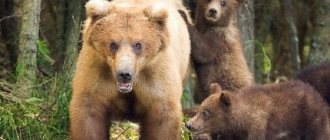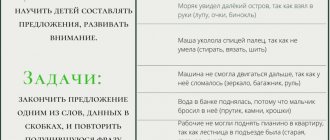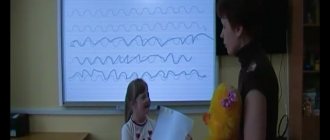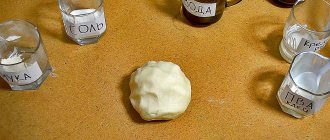Goals:
clarify children's knowledge about animals;
know the names, their external signs, habits, how they move, what they eat, where they live, etc.; form complex adjectives, possessive adjectives, nouns using the suffix -ish;
selection of antonym words; agree numerals with nouns; practice selecting epithets; develop vocabulary on this topic.
Equipment:
demonstration material - pictures depicting wild animals and their body parts.
Progress of the lesson
1. Organizing time
- The one who names the animals that live in the forest will sit down.
2. Conversation based on pictures about wild animals
. The speech therapist displays pictures of animals.
-What are these animals called? (Wild.)
Why? a) The speech therapist asks a riddle:
A cunning cheat, a red head, a fluffy tail - a beauty - and her name is... (Fox.)
What fox? (Cunning, fast, red-haired, dexterous...)
Who else lives with a fox? (fox, little fox, fox cubs.)
Didactic game “Whose is this?” (based on pictures)
(Fox face, fox ears, etc.) Formation of complex adjectives:
The fox has thin paws. What fox? (Thin-footed.)
The fox has a long nose.
The fox has pointed ears.
The fox has short whiskers.
The fox has a red tail.
The red fox has beautiful thick, fluffy fur. Her body is very mobile, it can bend and stretch when running. The fox has a long fluffy tail. The muzzle is elongated, the ears are pointed and erect, the eyes have oval pupils. The fox's legs are short and thin. She is an omnivore, but loves fresh meat most of all. Hunts mice, water rats, hares. The fox has good hearing and sense of smell. In winter, she hears mice squeaking under a layer of snow. The fox quickly digs up the snow and catches them. She also has many enemies, of which the most dangerous is the wolf.
b) The speech therapist asks a riddle: He walks with a club foot in the summer,
And in winter he sucks his paw. (Bear.)
What bear? (Clubfooted, clumsy, brown, shaggy...)
Didactic game “Whose is this?” (Based on pictures.) (Bear paw, etc.)
Name the members of the bear's family. (Bear, she-bear, cub , cubs.)
What is the name of a bear's home? (Den.)
The bear has a huge, clumsy body covered with brown fur. He has a large head, a short and thick neck, and small eyes. The bear has poor eyesight. The ears are small and round. When walking, he places his paws inward with his claws and outward with his heels. That's why the bear was called clubfoot. The bear is a very strong animal. It feeds on mushrooms, berries, nuts, birds living on the ground, and small animals. He especially loves to eat honey, and even got his name for this - a bear: he knows where the honey is. In autumn, it feeds intensively and accumulates fat. With the onset of cold weather, the bear falls asleep in its den.
c) The speech therapist asks a riddle: Who is cold in winter?
Is he wandering around angry and hungry? (Wolf.)
- Continue the sentence according to the meaning: The wolf is the father in the family of wolves. Mom - ... (she-wolf).
Children - ...
(wolf cubs).
Formation of nouns with a diminutive suffix and using the suffix -ish:
- The she-wolf has a mustache. The wolf cub has mustaches. The wolf has a mustache. (Similarly: eyes, nose, tail.)
- What wolf? (Angry, hungry, gray, toothy, fanged, stupid ...)
Didactic game “Whose is this?”
— Among wild animals, the wolf stands out for its strength, intelligence, and endurance. The wolf has coarse, thick fur, a large head, a wide forehead, a thick neck, protruding ears, and sharp teeth. The wolf has well-developed paws. They are tall, strong, and have strong, sharp claws. The wolf has excellent eyesight. He sees even in the dark. Hearing is acute. Can hunt for prey for a long time. And as soon as she loses strength and cannot run, the wolf immediately attacks her. The wolf is a predatory animal that eats meat, but only weak, sick animals become its prey. It’s not for nothing that this predator is called the “forest orderly.” The wolf lives in a den, which he makes not far from a pond, in a remote place.
d) The speech therapist asks a riddle: You and I recognize the animal by these two signs: He wears a white fur coat in the winter, And a gray fur coat in the summer. (Hare.)
—
What hare?
(Fast, cowardly, gray, white, dexterous...)
Didactic game “Say the opposite”: black - white, brave - cowardly, fast - slow, cheerful - sad, smart - stupid, long - short.
— The hare has beautiful, fluffy, soft fur. During a jump, the hare throws forward first its long hind legs, and then its short front legs. Doesn't make holes. During the day it lies under a bush and at night it gets its food. In summer it eats grass, in winter it eats hay, bark of trees and shrubs. The hare has many enemies: fox, wolf, hawk, owl, eagle. In winter, its white color saves it.
3. Physical education minute
4. Continuing the conversation about wild animals.
The speech therapist asks a riddle:
The tail is in a fluffy arch. Do you know this animal?
Sharp-toothed, dark-eyed,
Loves to climb trees.
He builds his house in a hollow,
So that the animal can live in warmth. (Squirrel.)
What squirrel? (Fast, dexterous, beautiful, fluffy, nimble, red...)
Count how many squirrels are in the picture? (one squirrel, two squirrels...)
The big squirrel is mom. What's her name? (Belchiha.)
And the little ones are children.
What are they called? (Squirrel.)
And one -
(Squirrel.)
Didactic game “Whose is this?”
— A squirrel is a small, defenseless animal. She has fluffy, reddish fur and bulging black eyes. A large fluffy tail, the size of a squirrel itself. Ears with tassels protrude from the back of the head. The squirrel's teeth are large, curved and very sharp. It feeds on nuts and seeds of coniferous trees. For the winter, she stores nuts and acorns in hollows and dries mushrooms on the branches of bushes. The squirrel escapes from enemies only by hiding in dense tree branches and hollows.
b) The speech therapist asks a riddle: Angry touchy-feely
Lives in the wilderness of the forest. There are a lot of needles, but not a single thread. (Hedgehog.)
- What hedgehog? (Prickly, angry, dexterous, fast, brave, smart ...)
- Name his family. (Hedgehog, hedgehog, hedgehog, hedgehog.)
Didactic game "Finish the sentence."
You saw (who?) ... a hedgehog in the forest. We admire (who?) ... the hedgehog. We liked (who?) ... the hedgehog. We will give milk to (who?) ... the hedgehog. I told you (about whom?) ... about the hedgehog.
The hedgehog is an amazing animal, adapted to the most dangerous situations. Its body is covered with hard protruding needles. When in danger, the hedgehog curls up into a ball, and it turns out to be a needle-shaped ball that you can’t handle. The animal feeds on bugs, worms, and frogs. In winter, the hedgehog sleeps in a hole under the root of a large tree.
c) The speech therapist shows a picture and talks about the moose.
— Elk is a very large animal. He has high legs and a relatively short body. The large head has horns. The color of the moose is brownish-black. In summer, moose eat leaves, berries, and mushrooms. In winter, digging out snow, it looks for dry grass and eats tree bark.
5. Summary of the lesson
Fastening material
I. Clarify why they are called wild animals, what they eat, how they move, where they live. Know the names of the cubs, family. Choose epithets for each animal. Write a story about any animal.
II. Grammatical structure of speech and word formation.
1. Formation of plural nouns in the nominative and genitive cases.
For example:
wolf - wolves - wolves, etc.
2. Formation of nouns with a diminutive suffix.
For example:
squirrel - squirrel, etc.
3. Formation of complex adjectives.
For example:
The fox has a long tail. What fox? - Long-tailed.
The hare has a short tail - ... thin paws - ..., short paws - ..., thick paws -
..., long ears - ..., pointed ears - ..., short mustache - ....
4. Formation of possessive adjectives. For example:
Fox hole. Whose hole? - Fox. Bear's den. -...
Squirrel hollow. -...The wolf's lair. -... The face of a fox. -...Hare's tail. -...
Formation of nouns using the suffix -ish. For example:
nose - nose, etc. (paws, tail, mustache, eyes, teeth).
Selection of antonym words.
For example:
The fox has a long tail, and the hare has a short tail. The bear has thick paws, and the fox... etc.
7. Agreement of numerals with nouns. Didactic game "Count".
8. Fix the use of prepositions: on, with, around, between, because of, about.
Make up sentences using these prepositions and write them down in your notebook.









